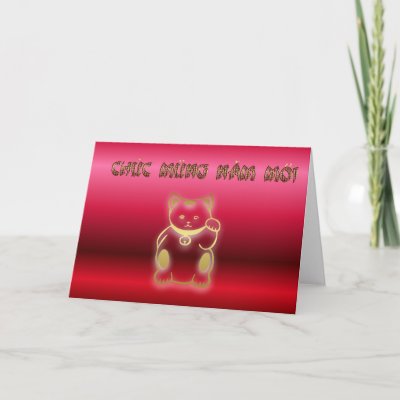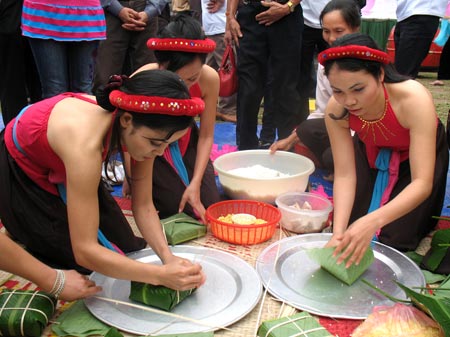Vietnam has many traditional and religious holidays but none can be compared to New Year festival, Tet Nguyen-Dan or, in short, Tet, which may fall in late January or early February.
Vietnamese believe the first day and the first week of the new year will determine the fortunes or misfortunes for the rest of the year. It is a time to pay debts, forgive others, correct one's faults, and start the new year with a clean slate. During Tet, all actions should be pure and beautiful as the attitude of the first few days of the new year sets the tone for the remainder of the year. During the Tet festival, all stores are closed and businesses are interrupted for at least 3 days.
The first signs of the impending holiday show up a month before Tet. Workmen start building stalls near the markets to sell holiday items such as New Year's greeting cards, candied fruits and decorations. Prices for everything begin to rise. Houses and buildings get a coat of new paint. People buy new clothes, exchange greeting cards, wish each other Happy New Year (Chuc Mung Nam Moi).

It is auspicious if the branches bloom on the first morning of Tet: apricot blossoms are reputed to keep demons out of the homes at this time. The ideal is to have the flowers bloom just at Tet, so much care is given in picking just the right braches. Some families buy entire apricot trees and decorate them with greeting cards from well-wishers. Families also paste up strips of red paper, cau doi, with sayings of wealth, happiness, prosperity, and longevity; They also buy fruits with names reminding them of their wishes for the coming year. A bamboo pole, (New Year's Tree, C�y N�u) stripped of its leaves except for a tuft on top, is planted at the front yard to drive evils away. Families gather together making the traditional Banh Chung, the cake of sticky rice, and fruit candies (Mut). Traditionally, no cooking is done during the three day holiday, so all food must be prepared beforehand.

The entire house should be cleaned before New Year's Day. On New Year's Eve, all brooms, brushes, dusters, dust pans and other cleaning equipment are hidden away. Sweeping or dusting are not be done on New Year's Day and the next two days for fear that good fortune will be swept away. After the first three days, the floors may be swept in a special routine. Beginning at the door, the dust and rubbish are swept to the middle of the parlor, then placed in the corners and not taken or thrown out until the fifth day.

New Year's Eve, Giao Thua, is the transition moment between the old year and the new year. It is one of the most important moments during the Tet holiday. By ten o'clock on New Year's Eve, all streets are deserted. Everyone stays at home awaiting the magic hour of midnight. The even of Tet is celebrated with fireworks. It is believed that the loud noise of the fireworks will scare the evil spirits away. Massive strings of fireworks, the longer the better, are attached to the front of every house. When New Year's Eve comes, everyone competes in firing crackers. Joss-sticks are lit on the family altar and offerings are made of food, fresh water, flowers and betel. Nobody dares sleep at this moment for fear of "loosing one age". All members of the family gather in the living room, pray together, then congratulate the New Year and wish each other the very bests for the coming year; everyone is congratulated and offered wishes for the New Year beginning with the eldest set of parents (usually the grandparents), then the rest of the family according to order.

On the morning of the New Year's Day (Mong Mot Tet), everybody puts on new clothes and joyfully greets each other Happy New Year. Children vow to be well-behaved and offer wishes to the adult (parents, relatives, or visitors). The adults in return give children money in a red envelop (Li Xi).


People will visit the most important persons to them on the first day, and the less important ones on the second and third days. The first visitor of the year to a house is the most significant, being a portent of the coming year's fortune. Particular care is taken to arrange in advance to have the visitor be rich, happy, and prosperous. After the initial greeting, visitors are served fruit candies and dried watermelon seeds. Tet is the most appropriate occasion for business people to treat each other generously. These Tet visits are taken seriously. It is also customary that people wish each other all sorts of good things. There are many activities at the pagodas, churches, and in the family. Relatives' graves are visited.
Licorn Dance (Mua Lan) is a joyful entertainment at the Tet festival in Viet Nam. The Licorn is the symbol of power and prosperity. Their dances, accompanied by firecrackers, frighten away bad spirits. Wealthy families used to set prize money and invite the Licorn Dance team to come and dance in front of their house or store. Gambling is also a favorite during the three days of Tet and beyond.
For three days, one takes extra care not to show anger and not to be rude to people. When the holiday ends, people resume their activities in a new spirit following so-called opening rituals in which the ploughman will open the first furrow, the official applies his seal to the first document, the scholar traces the first character with his pen brush, the trader receives his first customer.
While many Vietnamese today may not believe in these dos and donts, these traditions and customs are still practiced. They are kept because most families realize that these very traditions, whether believed or not, provide a continuity with the past and support the family with a strong bond and unique identity.
HAPPY NEW YEAR 2011- CHUC MUNG NAM MOI 2011
Searches related to vietnamese new year cards
vietnamese new year greeting cards
vietnamese new year ecards
chinese new year cards
vietnamese new year cards 2010
vietnamese new year tet greeting cards
lunar new year
vietnamese new year wishes
new years greetings card
Post a Comment